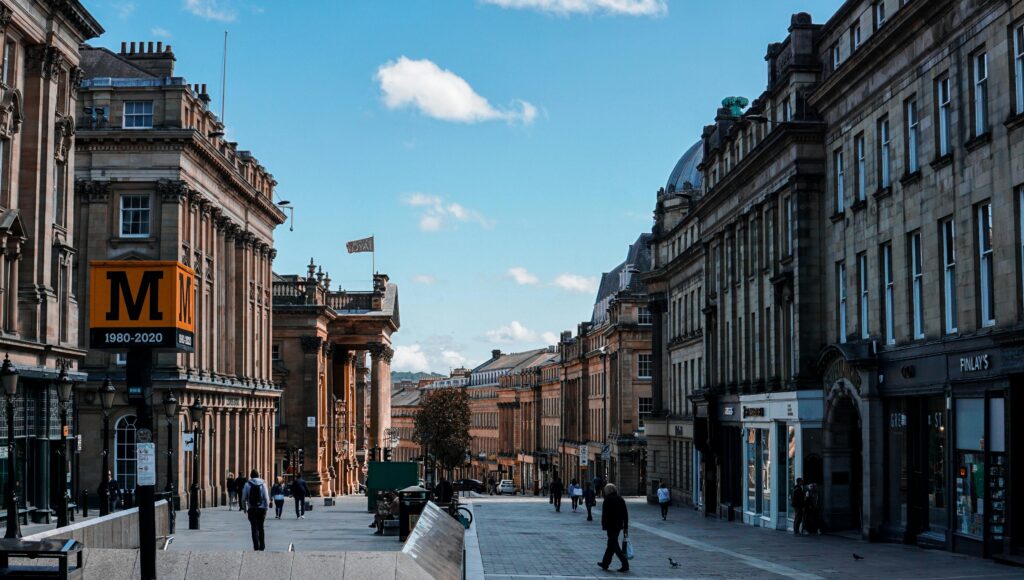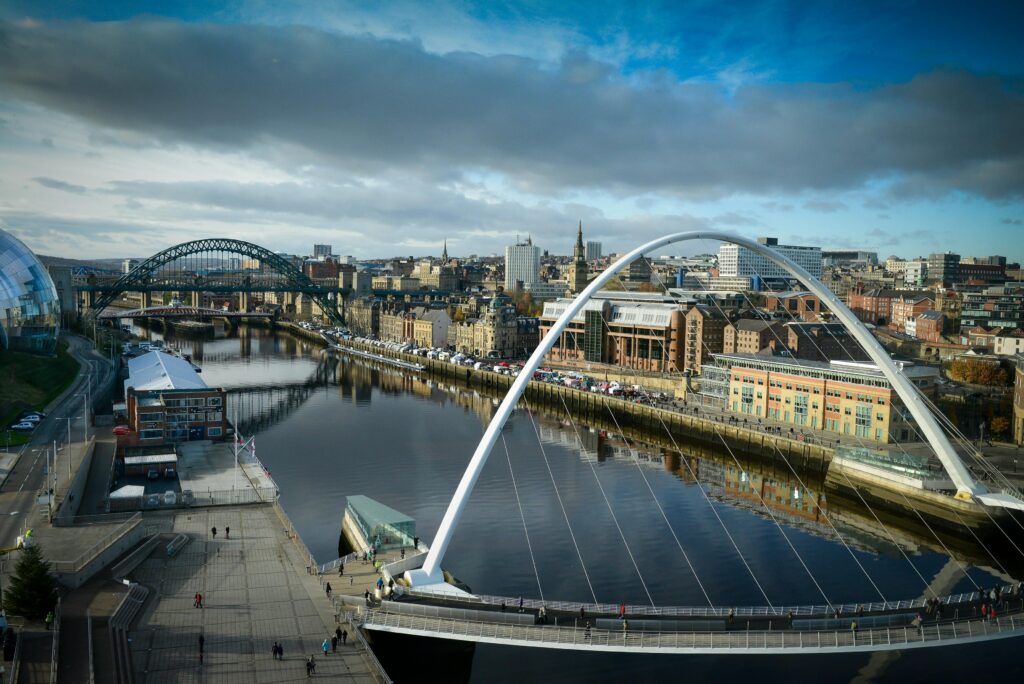Newcastle upon Tyne, often simply called Newcastle, is a city in northeast England that boasts a history as vibrant and dynamic as its present. Nestled on the banks of the River Tyne, this city has been a hub of activity for nearly 2,000 years. From its origins as a Roman settlement to its transformation into a modern cultural and economic powerhouse, Newcastle’s story is one of resilience, innovation, and transformation. In this blog, we’ll take a deep dive into the rich tapestry of Newcastle’s history, exploring its key milestones, influential figures, and enduring legacy.




Roman Beginnings: The Birth of Pons Aelius
Newcastle’s history begins in the Roman era, around 122 AD, when Emperor Hadrian ordered the construction of a wall to mark the northern frontier of the Roman Empire. This wall, known as Hadrian’s Wall, stretched 73 miles across northern England, from the River Tyne in the east to the Solway Firth in the west. At the eastern end of the wall, the Romans established a fort and settlement called Pons Aelius, meaning “Aelian Bridge,” named after the family of Emperor Hadrian.
Pons Aelius was a strategic outpost, serving as a military base and a crossing point over the River Tyne. The fort housed Roman soldiers and their families, and its location made it a vital link in the empire’s northern defenses. Although much of the Roman settlement has been lost to time, remnants of Hadrian’s Wall can still be seen in parts of Newcastle, offering a glimpse into the city’s ancient past.
The Anglo-Saxon Era: From Manchester to New Castle
After the fall of the Roman Empire in the 5th century, Newcastle entered a period of decline. The settlement, then known as Manchester, became a small Anglo-Saxon village. Its name reflects the presence of monks who lived in the area, maintaining a Christian presence during the early medieval period.
The turning point for Newcastle came in 1080, when Robert Curthose, the eldest son of William the Conqueror, built a wooden castle on the site of the former Roman fort. This castle was later rebuilt in stone by Henry II in the 12th century, giving the city its iconic name: New Castle upon Tyne. The castle served as a defensive stronghold and a symbol of Norman power in the region.
Medieval Newcastle: Trade, Religion, and Conflict
During the medieval period, Newcastle grew into a thriving market town. Its strategic location on the River Tyne made it a key trading hub, particularly for wool, coal, and timber. The city’s economy flourished, and its population expanded.
One of the most significant developments of this era was the construction of Newcastle Cathedral, originally the Church of St. Nicholas. Built in the 14th and 15th centuries, this stunning example of Gothic architecture remains a landmark of the city. The cathedral’s lantern tower, added in the 15th century, served as a beacon for ships navigating the Tyne.
Newcastle’s medieval history was also marked by conflict. The city played a crucial role in the Wars of the Roses and the English Civil War, with its castle and walls providing defense against invading forces. The town walls, built in the 13th and 14th centuries, were among the most extensive in England, reflecting Newcastle’s importance as a northern stronghold.
The Industrial Revolution: Newcastle’s Golden Age
The 18th and 19th centuries brought unprecedented growth and transformation to Newcastle, as the city became a powerhouse of the Industrial Revolution. The discovery of vast coal reserves in the region fueled the city’s rise, earning it the nickname “The Coal Metropolis of the World.”
Coal mining and shipbuilding became the backbone of Newcastle’s economy. The River Tyne was lined with shipyards, producing some of the most advanced vessels of the time. Innovations in engineering and manufacturing, such as the development of the steam engine by George Stephenson, a native of nearby Wylam, cemented Newcastle’s reputation as a center of industrial innovation.
The city’s infrastructure also underwent significant changes during this period. The construction of the High-Level Bridge in 1849, designed by Robert Stephenson, connected Newcastle with Gateshead and facilitated the movement of goods and people. The bridge remains a symbol of the city’s engineering prowess.
Victorian Newcastle: Culture and Expansion
The Victorian era saw Newcastle evolve into a bustling urban center, with grand public buildings, parks, and cultural institutions. The city’s wealth from industry funded the construction of landmarks such as the Grainger Town area, designed by architect Richard Grainger. This neoclassical district, with its elegant streets and squares, is still a defining feature of Newcastle’s cityscape.
Newcastle also became a cultural hub during this time. The Theatre Royal, opened in 1837, hosted performances by some of the era’s most renowned actors and playwrights. Meanwhile, the Laing Art Gallery and the Hancock Museum (now the Great North Museum) showcased the city’s commitment to art and education.
The 20th Century: Challenges and Resilience
The 20th century brought both challenges and opportunities for Newcastle. The decline of heavy industry in the mid-20th century led to economic hardship and unemployment. Shipyards closed, coal mines were abandoned, and the city faced an uncertain future.
However, Newcastle proved resilient. The latter half of the century saw efforts to diversify the economy and revitalize the city. The development of the Metro system in the 1970s and 1980s improved transportation, while the construction of the Eldon Square shopping center boosted retail activity.
The city also embraced its cultural heritage, with events like the Newcastle International Film Festival and the Hoppings Fair drawing visitors from across the country. The transformation of the Quayside area, once dominated by industrial activity, into a vibrant cultural and leisure destination, symbolized Newcastle’s ability to adapt and thrive.
Modern Newcastle: A City Reimagined
Today, Newcastle is a dynamic and cosmopolitan city, known for its rich history, vibrant culture, and friendly locals. The city’s skyline is a blend of historic landmarks and modern architecture, reflecting its journey from a Roman settlement to a 21st-century metropolis.
The Sage Gateshead, a stunning concert venue on the Quayside, and the BALTIC Centre for Contemporary Art, housed in a converted flour mill, are testaments to Newcastle’s commitment to the arts. Meanwhile, the city’s universities, including Newcastle University and Northumbria University, attract students from around the world, contributing to its youthful and innovative spirit.
Newcastle’s sporting culture also remains a defining feature. The city is home to St. James’ Park, the iconic stadium of Newcastle United Football Club, which has a passionate fan base and a storied history.
Conclusion: A City Steeped in History
Newcastle’s history is a testament to its resilience and adaptability. From its Roman origins to its industrial heyday and modern reinvention, the city has continually evolved, embracing change while preserving its unique identity. Whether you’re exploring the remnants of Hadrian’s Wall, strolling along the Quayside, or enjoying a night out in the city’s bustling nightlife, you’re walking in the footsteps of centuries of history.
Newcastle is more than just a city; it’s a living, breathing chronicle of England’s past, present, and future. Its story is one of triumph over adversity, innovation in the face of challenge, and an enduring spirit that continues to inspire. So, the next time you visit Newcastle, take a moment to appreciate the rich tapestry of history that surrounds you—it’s a journey through time you won’t soon forget.
Thanks for joining me on this journey!
I’d love to hear your thoughts—feel free to share them in the comments below!
Abdelilah Hamma
Follow me on Instagram for more travel inspiration!
March 19, 2025
